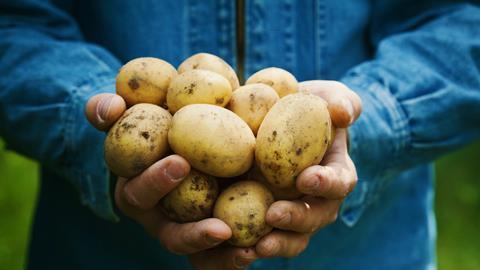Royal Avebe is collaborating with CarbExplore Research and the University Medical Centre Groningen (UMCG) to develop new healthy starch varieties based on enzymatic production to reduce its carbon footprint.
When you think of ‘The Potato Eaters’ by Vincent van Gogh, you probably don’t picture a healthy family sitting around the table. Nineteenth-century diets were unbalanced and living conditions were harsh. But potatoes are in fact an important raw material for healthy food ingredients. Avebe, producer of potato starch and proteins, is constantly innovating in the development of healthier food ingredients based on potato starch.
Marc Laus, Technology Officer Product & Applications at the company, says Avebe is looking to green existing processes and also expand its product portfolio of healthy starch products. ‘By changing the structure of starch, you can give it different functionalities’, says Laus. ‘For example, certain starches can be used as thickeners or gelling agents to give food a good texture. You can also give food the ability to retain moisture during freezing or thawing, or to retain its quality upon heating.’
Smaller environmental footprint
In addition, certain types of starch have a positive effect on gut health. They are digested slowly, which helps to keep blood sugar levels stable. Currently, many starch variations are produced by chemical reactions: cross-linking, oxidation, the addition of carboxyl groups or the addition of side groups. Or physically, by heating the starch or applying pressure. ‘These developments have been going on since the 1960s. In short, it’s an outdated field’, says Laus. ‘We believe we can use enzymatic processes to give starch other functionalities without having to use chemical processes.’ In this way, Avebe hopes to develop variants that will have a positive effect on health and, at the same time, give food a good texture.
’By changing the structure of starch, you can give it different functionalities’
Marc Laus
Enzymatic processes also have a smaller environmental footprint, says Laus. ‘With enzymatic processes, there is no need to rinse waste water streams. This allows us to reduce water consumption.’ The energy consumption of bio-catalysed processes is also lower because they take place at room temperature and normal pressure. Avebe is already producing a number of products in this way, and it is enabling the company to expand its portfolio of sustainable products.
Toolbox
Finding the right enzymes for starch conversion is the starting point of the project. To this end, Avebe is collaborating with UMCG and CarbExplore Research in the FIBERS project (Functional Ingredients by Enzymatic Redesign of Starch), for which the parties received €1.4 million in European funding from the Just Transition Fund. The first part of the project concerns the development and production of new starch variants using enzymes. This is where the expertise of CarbExplore Research comes in. This innovative company identifies and selects specific carbohydrate-modifying enzymes.
Marcel van der Sluis, Chief Business Officer of CarbExplore Research, explains that the use of enzymes opens up many possibilities. ‘Enzymes allow you to look at starch differently. You have a different toolbox than with chemical conversions, so you can also achieve other functionalities.’ This applies, for example, to the digestibility of starch variants, he continues. ‘Starch is made up of two biopolymers, amylose and amylopectin. Both are composed of glucose monomers linked by rapidly digestible bonds. By using glucanotransferase enzymes, you can change the glucose bonds in starch so that it is digested more slowly. This has a positive effect on health.’ Research in FIBERS is also focused on finding new structures that give food texture.
AI modelling software
The first challenge for the scientists is to find enzymes that carry out these reactions and are stable under process conditions. Van der Sluis: ‘It is known that glucanotransferase enzymes can modify the starch structure. This class of enzymes is therefore the starting point of our search.’ The use of digital tools makes this task much less time-consuming. ‘We search genome databases for specific DNA sequences of bacteria that can potentially produce these types of enzymes. This allows us to select the enzymes that we want to test for the reactions in an experimental setting.’
’Using enzymes, you have different toolbox compared to chemical conversions’
Marcel van der Sluijs
For several years now, modelling software such as AlphaFold has been speeding up the experiments, explains van der Sluis. ‘It allows us to quickly gain knowledge about the three-dimensional structure of enzymes. We use it to try to understand how an enzyme works. Thanks to modelling, we can also find out which parts of the enzyme are not needed to catalyse the process. By making the enzyme smaller, we can make it easier to produce.’
A realm of possibilities
After an initial selection from a large number of candidate enzymes, Avebe will further investigate the two or three most promising enzymes. The company will look at activity and selectivity, as well as the starch variations that can be produced. ‘Then we will look at exactly what properties these variations have in terms of texture; resistance to food processing conditions such as heat, moisture and pressure, among others’, explains Laus. This area of biocatalysis is still largely unexplored and the functionalisation of starch with enzymes is relatively new.’ Avebe currently has two products in its portfolio that are produced using enzymes. ‘This means that there is still a realm of opportunities.’













Nog geen opmerkingen